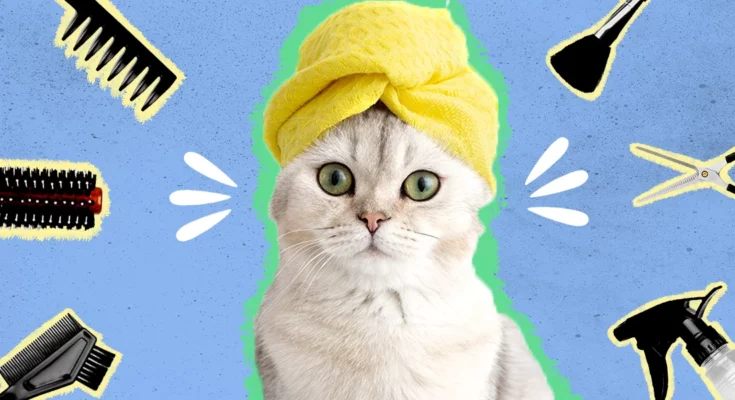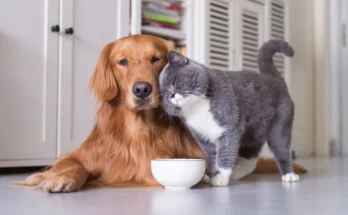Cats are known for being clean animals. You have probably seen your cat licking its fur many times a day. This self-grooming keeps them clean, but that doesn’t mean they don’t need help from us. Regular grooming is an important part of cat care, and it helps keep your cat healthy, happy, and looking great.
In this article, we will talk about why grooming is important, how to groom your cat step by step, and some tips to make it easier for both you and your furry friend.
Why is Cat Grooming Important?
Cats groom themselves naturally, but sometimes they need a little extra help from their owners. Here’s why:
- Reduces Shedding – Cats shed fur, and if you brush them regularly, you can remove loose hair before it ends up all over your house or in hairballs.
- Prevents Hairballs – Cats swallow hair while licking themselves. Grooming reduces the amount of hair they swallow, lowering the risk of hairballs.
- Healthy Skin and Coat – Brushing spreads natural oils in their fur, making it smooth and shiny.
- Early Health Check – Grooming lets you check for skin problems, bumps, parasites (like fleas), or injuries.
- Bonding Time – Grooming is also a way to spend quality time with your cat, which can strengthen your bond.
How Often Should You Groom Your Cat?
- Short-haired cats – Once a week is usually enough.
- Long-haired cats (like Persians) – Every day or every other day to prevent tangles and mats.
- Older cats – May need more help because they are less flexible and cannot groom themselves as easily.
Grooming Tools You Will Need
Having the right tools makes grooming easier and safer. Here are some useful tools:
- Brush or comb – Choose one depending on your cat’s coat type.
- Nail clippers – For trimming claws safely.
- Cat-safe wipes or damp cloth – For cleaning dirty areas.
- Pet-friendly shampoo – For occasional baths.
- Ear cleaner and cotton balls – For cleaning ears gently.
- Toothbrush and cat-safe toothpaste – For dental care.
Step-by-Step Cat Grooming
1. Brushing Your Cat’s Fur
- Find a calm and quiet place where your cat feels safe.
- Use gentle strokes with a brush or comb.
- Always brush in the direction of hair growth.
- Pay extra attention to areas where mats often form, like behind the ears, under the legs, and around the tail.
- Give treats during grooming to make it a positive experience.
2. Bathing Your Cat (Optional)
Most cats don’t need frequent baths because they groom themselves well. But sometimes, if your cat gets into something sticky or dirty, a bath is necessary.
- Use a special cat shampoo, never human shampoo.
- Fill a small tub or sink with warm water (not hot).
- Gently wet your cat and apply shampoo, avoiding eyes and ears.
- Rinse well and dry with a soft towel.
(Tip: Some cats dislike water, so try dry shampoos or cat wipes if bathing is too stressful.)
3. Trimming Nails
Cats need their nails trimmed to prevent overgrowth and scratching injuries.
- Use special cat nail clippers.
- Press gently on the paw to extend the claw.
- Cut only the tip (avoid the pink area called the “quick”).
- Trim regularly every 2–3 weeks.
4. Cleaning Ears
- Check ears for dirt, wax, or redness.
- Use a vet-approved ear cleaner and cotton ball.
- Gently wipe the inside (do not push deep into the ear).
5. Dental Care
Cats can have dental problems like tartar and gum disease.
- Brush their teeth with cat-safe toothpaste 2–3 times a week.
- You can also give dental treats or toys to help keep teeth clean.
Special Grooming for Long-Haired Cats
Long-haired cats like Persians or Maine Coons need more grooming care:
- Daily brushing to prevent mats and tangles.
- Trim fur around the bottom to keep it clean and avoid litter problems.
- Check for knots behind ears and under the belly regularly.
Handling Cats That Don’t Like Grooming
Not all cats enjoy grooming. If your cat is nervous:
- Start grooming when they are relaxed or sleepy.
- Keep sessions short, around 5–10 minutes.
- Use treats and praise to reward calm behavior.
- Never force grooming, as it may stress your cat more.
Over time, most cats learn to enjoy or at least tolerate grooming.
When to Seek Professional Grooming
Sometimes you may need a professional groomer or a vet:
- If your cat has very matted fur.
- If your cat is aggressive during grooming.
- For special grooming like lion cuts or full baths for long-haired breeds.
Grooming for Kittens and Senior Cats
- Kittens – Start grooming early so they get used to it. Use gentle brushes and keep it playful.
- Senior Cats – They might need more frequent brushing and nail trimming because they groom themselves less.
Tips to Make Grooming Easier
- Groom in a quiet, safe space.
- Use slow, gentle movements.
- Make it a routine (same time of day).
- Reward your cat after each session.
- Keep your grooming tools clean.
Final Thoughts
Grooming is an important part of keeping your cat healthy and happy. It prevents shedding, mats, and hairballs while also giving you a chance to check your cat’s overall health. Start slowly, be gentle, and turn grooming into a bonding experience rather than a stressful one.
Whether you have a short-haired cat or a long-haired beauty, a little grooming goes a long way. Your cat will look great, feel comfortable, and enjoy the extra attention from you.




